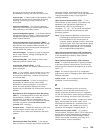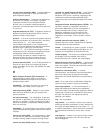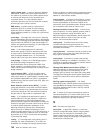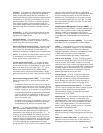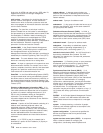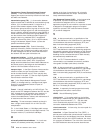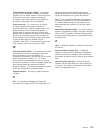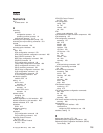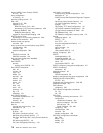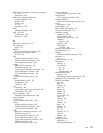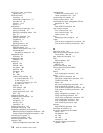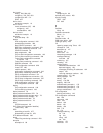Transmission Control Protocol/Internet Protocol
(TCP/IP). A set of communications protocols that
support peer-to-peer connectivity functions for both local
and wide area networks.
transmission group (TG). (1) A connection between
adjacent nodes that is identified by a transmission group
number. (2) In a subarea network, a single link or a
group of links between adjacent nodes. When a
transmission group consists of a group of links, the links
are viewed as a single logical link, and the transmission
group is called a
multilink transmission group (MLTG)
.A
mixed-media multilink transmission group (MMMLTG)
is
one that contains links of different medium types (for
example, token-ring, switched SDLC, nonswitched
SDLC, and frame-relay links). (3) In an APPN network,
a single link between adjacent nodes. (4) See also
parallel transmission groups
.
transmission header (TH). Control information,
optionally followed by a basic information unit (BIU) or a
BIU segment, that is created and used by path control
to route message units and to control their flow within
the network. See also
path information unit
.
transparent bridging. In LANs, a method for tying
individual local area networks together through the
medium access control (MAC) level. A transparent
bridge stores the tables that contain MAC addresses so
that frames seen by the bridge can be forwarded to
another LAN if the tables indicate to do so.
transport layer. In the Open Systems Interconnection
reference model, the layer that provides a reliable
end-to-end data transfer service. There may be relay
open systems in the path. (T) See also
Open Systems
Interconnection reference model
.
trap. In the Simple Network Management Protocol
(SNMP), a message sent by a managed node (agent
function) to a management station to report an
exception condition.
Tunnel. A tunnel is defined by an LNS-LAC pair. The
tunnel carries PPP datagrams between the LAC and the
LNS. A single tunnel can multiplex many sessions. A
control connection operating over the same tunnel
controls the establishment, release, and maintenance of
all sessions and of the tunnel itself.
tunneling. To treat a transport network as though it
were a single communication link or LAN. See also
encapsulation
.
T1. In the United States, a 1.544-Mbps public access
line. It is available in twenty-four 64-Kbps channels. The
European version (E1) transmits 2.048 Mbps.
U
universally administered address. In a local area
network, the address permanently encoded in an
adapter at the time of manufacture. All universally
administered addresses are unique. Contrast with
locally administered address
.
User Datagram Protocol (UDP). In the Internet suite
of protocols, a protocol that provides unreliable,
connectionless datagram service. It enables an
application program on one machine or process to send
a datagram to an application program on another
machine or process. UDP uses the Internet Protocol
(IP) to deliver datagrams.
V
V.24. In data communication, a specification of the
CCITT that defines the list of definitions for interchange
circuits between data terminal equipment (DTE) and
data circuit-terminating equipment (DCE).
V.25. In data communication, a specification of the
CCITT that defines the automatic answering equipment
and parallel automatic calling equipment on the General
Switched Telephone Network, including procedures for
disabling of echo controlled devices for both manually
and automatically established calls.
V.34. An ITU-T Recommendation for modem
communication over standard commercially available
voice-grade 33.6-Kbps (and slower) channels.
V.35. In data communication, a specification of the
CCITT that defines the list of definitions for interchange
circuits between data terminal equipment (DTE) and
data circuit-terminating equipment (DCE) at various data
rates.
V.36. In data communication, a specification of the
CCITT that defines the list of definitions for interchange
circuits between data terminal equipment (DTE) and
data circuit-terminating equipment (DCE) at rates of 48,
56, 64, or 72 kilobits per second.
version. A separately licensed program that usually
has significant new code or new function.
VINES. VIrtual NEtworking System.
virtual circuit. (1) In packet switching, the facilities
provided by a network that give the appearance to the
user of an actual connection. (T) See also
data
circuit
. Contrast with
physical circuit
. (2) A logical
connection established between two DTEs.
virtual connection. In frame relay, the return path of a
potential connection.
virtual link. In Open Shortest Path First (OSPF), a
point-to-point interface that connects border routers that
are separated by a non-backbone transit area. Because
area routers are part of the OSPF backbone, the virtual
link connects the backbone. The virtual links ensure that
the OSPF backbone does not become discontinuous.
712 MRS V3.2 Software User’s Guide




